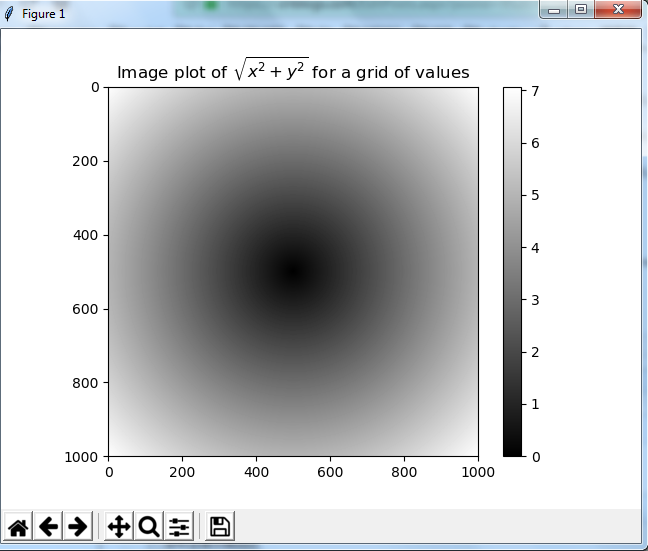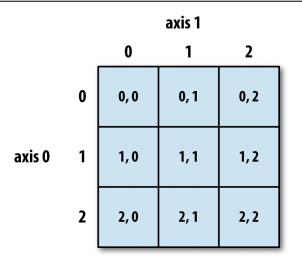1 names = np.array(['Bob', 'Joe', 'Will', 'Bob', 'Will', 'Joe', 'Joe'])
2 names
3 Out[37]: array(['Bob', 'Joe', 'Will', 'Bob', 'Will', 'Joe', 'Joe'], dtype='<U4')
# 中间出了一些错误调用random的时候需要俩括号,(7,4)作为一个tuple变量传入random
33 data = np.random.random((7,4))
34 data
35 Out[43]:
36 array([[0.89497078, 0.61138776, 0.69472434, 0.27105599],
37 [0.23114404, 0.1423609 , 0.06016109, 0.56939826],
38 [0.84711124, 0.00776355, 0.24954255, 0.96157959],
39 [0.34937375, 0.6013533 , 0.66481223, 0.18210067],
40 [0.82706912, 0.64240956, 0.95575726, 0.40232292],
41 [0.57225917, 0.0958916 , 0.969577 , 0.47824937],
42 [0.52181664, 0.59962513, 0.19175081, 0.92442871]])
# 注意random 和 randn的区别,numpy.random.randn(d0, d1, …, dn)是从标准正态分布中返回一个或多个样本值,numpy.random.rand(d0, d1, …, dn)的随机样本位于[0, 1)中。
43 data = np.random.randn(7,4)
44 data
45 Out[45]:
46 array([[-0.41118699, -0.55989348, -1.03263407, 0.06053961],
47 [ 0.91135901, -0.90451748, -1.12549659, 1.69668984],
48 [ 0.54079498, 1.23213331, 0.86787185, 2.33957776],
49 [-0.56646272, 0.87848794, -1.29842767, 0.65293394],
50 [ 0.96861489, 1.5155331 , 0.328894 , 0.25768648],
51 [-0.53991665, 0.3098865 , 2.18921935, 0.83933456],
52 [-1.21083646, -0.30640711, 0.36142124, 0.9664484 ]])
58 names = np.array(['Bob', 'Joe', 'Will', 'Bob', 'Will', 'Joe', 'Joe'])
# 通过判断重新生成array
59 names == 'Bob'
60 Out[50]: array([ True, False, False, True, False, False, False])
61 data
62 Out[51]:
63 array([[-0.41118699, -0.55989348, -1.03263407, 0.06053961],
64 [ 0.91135901, -0.90451748, -1.12549659, 1.69668984],
65 [ 0.54079498, 1.23213331, 0.86787185, 2.33957776],
66 [-0.56646272, 0.87848794, -1.29842767, 0.65293394],
67 [ 0.96861489, 1.5155331 , 0.328894 , 0.25768648],
68 [-0.53991665, 0.3098865 , 2.18921935, 0.83933456],
69 [-1.21083646, -0.30640711, 0.36142124, 0.9664484 ]])
#高级用法,根据names判断生成的array再进行一次迭代选择, 和切片还有区别
70 data[names == 'Bob']
71 Out[52]:
72 array([[-0.41118699, -0.55989348, -1.03263407, 0.06053961],
73 [-0.56646272, 0.87848794, -1.29842767, 0.65293394]])
# 切片的选择
74 data[names == 'Bob', 2:]
75 Out[53]:
76 array([[-1.03263407, 0.06053961],
77 [-1.29842767, 0.65293394]])
78 data[names == 'Bob', 3]
79 Out[54]: array([0.06053961, 0.65293394])
80 names
81 Out[55]: array(['Bob', 'Joe', 'Will', 'Bob', 'Will', 'Joe', 'Joe'], dtype='<U4')
82 names == 'Joe'
83 Out[56]: array([False, True, False, False, False, True, True])
84 names != 'Bob'
85 Out[57]: array([False, True, True, False, True, True, True])
#这一例程没成功,待调查。。。
86 data[-(names == 'Bob')]
87 Traceback (most recent call last):
88 File "E:SoftwareSoftwareAnaconda2.5.01envsintro_dllibsite-packagesIPythoncoreinteractiveshell.py", line 2963, in run_code
89 exec(code_obj, self.user_global_ns, self.user_ns)
90 File "<ipython-input-58-1242c1c7d3ed>", line 1, in <module>
91 data[-(names == 'Bob')]
92 TypeError: The numpy boolean negative, the `-` operator, is not supported, use the `~` operator or the logical_not function instead.
93 data
94 Out[59]:
95 array([[-0.41118699, -0.55989348, -1.03263407, 0.06053961],
96 [ 0.91135901, -0.90451748, -1.12549659, 1.69668984],
97 [ 0.54079498, 1.23213331, 0.86787185, 2.33957776],
98 [-0.56646272, 0.87848794, -1.29842767, 0.65293394],
99 [ 0.96861489, 1.5155331 , 0.328894 , 0.25768648],
100 [-0.53991665, 0.3098865 , 2.18921935, 0.83933456],
101 [-1.21083646, -0.30640711, 0.36142124, 0.9664484 ]])
102 data[-(names == 'Bob')]
103 Traceback (most recent call last):
104 File "E:SoftwareSoftwareAnaconda2.5.01envsintro_dllibsite-packagesIPythoncoreinteractiveshell.py", line 2963, in run_code
105 exec(code_obj, self.user_global_ns, self.user_ns)
106 File "<ipython-input-60-1242c1c7d3ed>", line 1, in <module>
107 data[-(names == 'Bob')]
108 TypeError: The numpy boolean negative, the `-` operator, is not supported, use the `~` operator or the logical_not function instead.
109 data
110 Out[61]:
111 array([[-0.41118699, -0.55989348, -1.03263407, 0.06053961],
112 [ 0.91135901, -0.90451748, -1.12549659, 1.69668984],
113 [ 0.54079498, 1.23213331, 0.86787185, 2.33957776],
114 [-0.56646272, 0.87848794, -1.29842767, 0.65293394],
115 [ 0.96861489, 1.5155331 , 0.328894 , 0.25768648],
116 [-0.53991665, 0.3098865 , 2.18921935, 0.83933456],
117 [-1.21083646, -0.30640711, 0.36142124, 0.9664484 ]])
118 -data
119 Out[62]:
120 array([[ 0.41118699, 0.55989348, 1.03263407, -0.06053961],
121 [-0.91135901, 0.90451748, 1.12549659, -1.69668984],
122 [-0.54079498, -1.23213331, -0.86787185, -2.33957776],
123 [ 0.56646272, -0.87848794, 1.29842767, -0.65293394],
124 [-0.96861489, -1.5155331 , -0.328894 , -0.25768648],
125 [ 0.53991665, -0.3098865 , -2.18921935, -0.83933456],
126 [ 1.21083646, 0.30640711, -0.36142124, -0.9664484 ]])
127 -data[names == 'Bob']
128 Out[63]:
129 array([[ 0.41118699, 0.55989348, 1.03263407, -0.06053961],
130 [ 0.56646272, -0.87848794, 1.29842767, -0.65293394]])
131 data[names != 'Bob']
132 Out[64]:
133 array([[ 0.91135901, -0.90451748, -1.12549659, 1.69668984],
134 [ 0.54079498, 1.23213331, 0.86787185, 2.33957776],
135 [ 0.96861489, 1.5155331 , 0.328894 , 0.25768648],
136 [-0.53991665, 0.3098865 , 2.18921935, 0.83933456],
137 [-1.21083646, -0.30640711, 0.36142124, 0.9664484 ]])
138 data[-names != 'Bob']
139 Traceback (most recent call last):
140 File "E:SoftwareSoftwareAnaconda2.5.01envsintro_dllibsite-packagesIPythoncoreinteractiveshell.py", line 2963, in run_code
141 exec(code_obj, self.user_global_ns, self.user_ns)
142 File "<ipython-input-65-5976a92eae9b>", line 1, in <module>
143 data[-names != 'Bob']
144 TypeError: ufunc 'negative' did not contain a loop with signature matching types dtype('<U4') dtype('<U4')
#组合选择
145 msk = (names == 'Bob') | (names == 'Will')
146 msk
147 Out[67]: array([ True, False, True, True, True, False, False])
148 data[msk]
149 Out[68]:
150 array([[-0.41118699, -0.55989348, -1.03263407, 0.06053961],
151 [ 0.54079498, 1.23213331, 0.86787185, 2.33957776],
152 [-0.56646272, 0.87848794, -1.29842767, 0.65293394],
153 [ 0.96861489, 1.5155331 , 0.328894 , 0.25768648]])
#根据判断冲洗赋值
154 data[data < 0] = 0
155 data
156 Out[70]:
157 array([[0. , 0. , 0. , 0.06053961],
158 [0.91135901, 0. , 0. , 1.69668984],
159 [0.54079498, 1.23213331, 0.86787185, 2.33957776],
160 [0. , 0.87848794, 0. , 0.65293394],
161 [0.96861489, 1.5155331 , 0.328894 , 0.25768648],
162 [0. , 0.3098865 , 2.18921935, 0.83933456],
163 [0. , 0. , 0.36142124, 0.9664484 ]])
164 arr = np.empty((8,4))
165 arr
166 Out[72]:
167 array([[6.23042070e-307, 4.22795269e-307, 2.04722549e-306,
168 6.23054972e-307],
169 [1.78019761e-306, 9.34608432e-307, 7.56599807e-307,
170 8.90104239e-307],
171 [1.16820282e-307, 6.23037317e-307, 1.69121639e-306,
172 1.78020848e-306],
173 [8.90094053e-307, 1.11261027e-306, 1.11261502e-306,
174 1.42410839e-306],
175 [7.56597770e-307, 6.23059726e-307, 1.42419530e-306,
176 1.37961302e-306],
177 [1.29060531e-306, 1.11261570e-306, 7.56602523e-307,
178 9.34609790e-307],
179 [8.34451504e-308, 1.22383391e-307, 1.33511562e-306,
180 8.90103560e-307],
181 [1.42410974e-306, 1.00132228e-307, 1.33511969e-306,
182 2.18568966e-312]])
183 for i in range(8):
184 a[i] = i
185
186 Traceback (most recent call last):
187 File "E:SoftwareSoftwareAnaconda2.5.01envsintro_dllibsite-packagesIPythoncoreinteractiveshell.py", line 2963, in run_code
188 exec(code_obj, self.user_global_ns, self.user_ns)
189 File "<ipython-input-73-077106ef35e3>", line 2, in <module>
190 a[i] = i
191 IndexError: index 2 is out of bounds for axis 0 with size 2
# arr[i]是行的地址,给行地址指针赋值相当于改写了整块内存的值, 整行赋值, 不知道理解的对不对
192 for i in range(8):
193 arr[i] = i
194
195 arr
196 Out[75]:
197 array([[0., 0., 0., 0.],
198 [1., 1., 1., 1.],
199 [2., 2., 2., 2.],
200 [3., 3., 3., 3.],
201 [4., 4., 4., 4.],
202 [5., 5., 5., 5.],
203 [6., 6., 6., 6.],
204 [7., 7., 7., 7.]])
205 arr[0] = 9
206 arr
207 Out[77]:
208 array([[9., 9., 9., 9.],
209 [1., 1., 1., 1.],
210 [2., 2., 2., 2.],
211 [3., 3., 3., 3.],
212 [4., 4., 4., 4.],
213 [5., 5., 5., 5.],
214 [6., 6., 6., 6.],
215 [7., 7., 7., 7.]])
216 arr[[4,3,0,6]]
217 Out[78]:
218 array([[4., 4., 4., 4.],
219 [3., 3., 3., 3.],
220 [9., 9., 9., 9.],
221 [6., 6., 6., 6.]])
222 arr = np.arange(15).reshape((3,5))
223 arr
224 Out[80]:
225 array([[ 0, 1, 2, 3, 4],
226 [ 5, 6, 7, 8, 9],
227 [10, 11, 12, 13, 14]])
# .T转置矩阵
228 arr.T
229 Out[81]:
230 array([[ 0, 5, 10],
231 [ 1, 6, 11],
232 [ 2, 7, 12],
233 [ 3, 8, 13],
234 [ 4, 9, 14]])
#np.dot 矩阵相乘
235 np.dot(arr.T, arr)
236 Out[82]:
237 array([[125, 140, 155, 170, 185],
238 [140, 158, 176, 194, 212],
239 [155, 176, 197, 218, 239],
240 [170, 194, 218, 242, 266],
241 [185, 212, 239, 266, 293]])
242 arr
243 Out[83]:
244 array([[ 0, 1, 2, 3, 4],
245 [ 5, 6, 7, 8, 9],
246 [10, 11, 12, 13, 14]])
247 arr.T
248 Out[84]:
249 array([[ 0, 5, 10],
250 [ 1, 6, 11],
251 [ 2, 7, 12],
252 [ 3, 8, 13],
253 [ 4, 9, 14]])
254 np.dot(arr.T, arr)
255 Out[85]:
256 array([[125, 140, 155, 170, 185],
257 [140, 158, 176, 194, 212],
258 [155, 176, 197, 218, 239],
259 [170, 194, 218, 242, 266],
260 [185, 212, 239, 266, 293]])
261 np.dot(arr, arr.T)
262 Out[86]:
263 array([[ 30, 80, 130],
264 [ 80, 255, 430],
265 [130, 430, 730]])
266 arr = np.arange(10)
#矩阵开方
267 np.sqrt(arr)
268 Out[88]:
269 array([0. , 1. , 1.41421356, 1.73205081, 2. ,
270 2.23606798, 2.44948974, 2.64575131, 2.82842712, 3. ])
271 np.exp(arr)
272 Out[89]:
273 array([1.00000000e+00, 2.71828183e+00, 7.38905610e+00, 2.00855369e+01,
274 5.45981500e+01, 1.48413159e+02, 4.03428793e+02, 1.09663316e+03,
275 2.98095799e+03, 8.10308393e+03])
276 x = np.random.randn(8)
277 y = np.random.randn(8)
278 x
279 Out[92]:
280 array([-0.80864713, -1.10307828, 0.39407346, -1.51956716, -0.69376606,
281 -0.5599136 , 0.37168709, -0.3947183 ])
282 y
283 Out[93]:
284 array([ 1.49291073, -0.30018043, -0.1632179 , -0.53365993, 2.48673945,
285 -0.72669644, -0.18439522, 2.03956463])
#俩矩阵相比较
293 np.maximum(x, y)
294 Out[95]:
295 array([ 1.49291073, -0.30018043, 0.39407346, -0.53365993, 2.48673945,
296 -0.5599136 , 0.37168709, 2.03956463])
297 arr = np.random.randn(7)
#矩阵相乘
298 arr*5
299 Out[97]:
300 array([-9.09778567, -1.2577255 , 2.85527111, -1.10915396, -3.61125732,
301 4.83669313, 0.49764244])
302 arr
303 Out[98]:
304 array([-1.81955713, -0.2515451 , 0.57105422, -0.22183079, -0.72225146,
305 0.96733863, 0.09952849])
306 arr = np.random.randn(7) * 5
307 arr
308 Out[100]:
309 array([ 2.02351861, 6.79384776, -5.29035855, 4.15965833, 7.93557854,
310 -1.93563595, 1.45949827])
#np.modf是个神奇的函数, 分别显示生辰改动连个不同矩阵
311 np.modf(arr)
312 Out[101]:
313 (array([ 0.02351861, 0.79384776, -0.29035855, 0.15965833, 0.93557854,
314 -0.93563595, 0.45949827]), array([ 2., 6., -5., 4., 7., -1., 1.]))
322 points = np.arange(-5, 5, 0.01)
323 xs, ys = np.meshgrid(points, points)
324 xs
325 Out[105]:
326 array([[-5. , -4.99, -4.98, ..., 4.97, 4.98, 4.99],
327 [-5. , -4.99, -4.98, ..., 4.97, 4.98, 4.99],
328 [-5. , -4.99, -4.98, ..., 4.97, 4.98, 4.99],
329 ...,
330 [-5. , -4.99, -4.98, ..., 4.97, 4.98, 4.99],
331 [-5. , -4.99, -4.98, ..., 4.97, 4.98, 4.99],
332 [-5. , -4.99, -4.98, ..., 4.97, 4.98, 4.99]])
333 ys
334 Out[106]:
335 array([[-5. , -5. , -5. , ..., -5. , -5. , -5. ],
336 [-4.99, -4.99, -4.99, ..., -4.99, -4.99, -4.99],
337 [-4.98, -4.98, -4.98, ..., -4.98, -4.98, -4.98],
338 ...,
339 [ 4.97, 4.97, 4.97, ..., 4.97, 4.97, 4.97],
340 [ 4.98, 4.98, 4.98, ..., 4.98, 4.98, 4.98],
341 [ 4.99, 4.99, 4.99, ..., 4.99, 4.99, 4.99]])
342 import matplotlib.pyplot as plt
343 Backend TkAgg is interactive backend. Turning interactive mode on.
344 z = np.sqrt(xs**2 + ys**2)
345 z
346 Out[109]:
347 array([[7.07106781, 7.06400028, 7.05693985, ..., 7.04988652, 7.05693985,
348 7.06400028],
349 [7.06400028, 7.05692568, 7.04985815, ..., 7.04279774, 7.04985815,
350 7.05692568],
351 [7.05693985, 7.04985815, 7.04278354, ..., 7.03571603, 7.04278354,
352 7.04985815],
353 ...,
354 [7.04988652, 7.04279774, 7.03571603, ..., 7.0286414 , 7.03571603,
355 7.04279774],
356 [7.05693985, 7.04985815, 7.04278354, ..., 7.03571603, 7.04278354,
357 7.04985815],
358 [7.06400028, 7.05692568, 7.04985815, ..., 7.04279774, 7.04985815,
359 7.05692568]])
#plt 的两个图像是进行叠加显示的。
360 plt.imshow(z, cmap=plt.cm.gray); plt.colorbar()
361 Out[110]: <matplotlib.colorbar.Colorbar at 0x8a3ccc0>
362 plt.title("Image plot of $sqrt{x^2 + y^2}$ for a grid of values")
363 Out[111]: Text(0.5,1,'Image plot of $\sqrt{x^2 + y^2}$ for a grid of values')
364 plt.imshow(z, cmap=plt.cm.gray); plt.colorbar()
365 Out[112]: <matplotlib.colorbar.Colorbar at 0xa894668>


